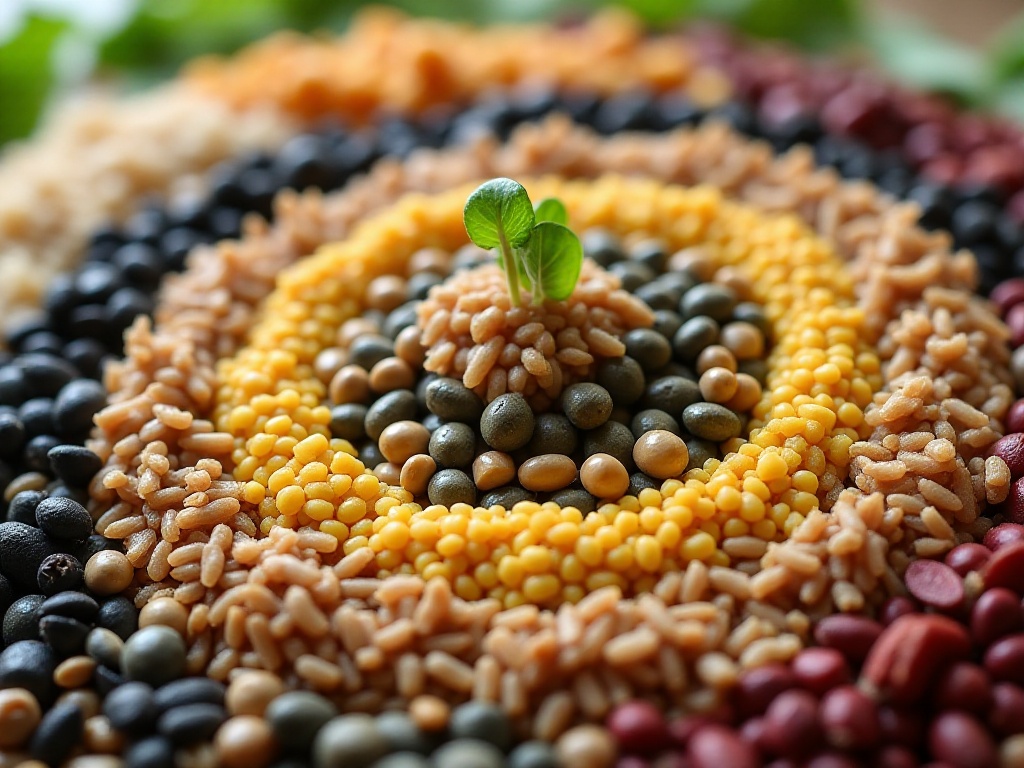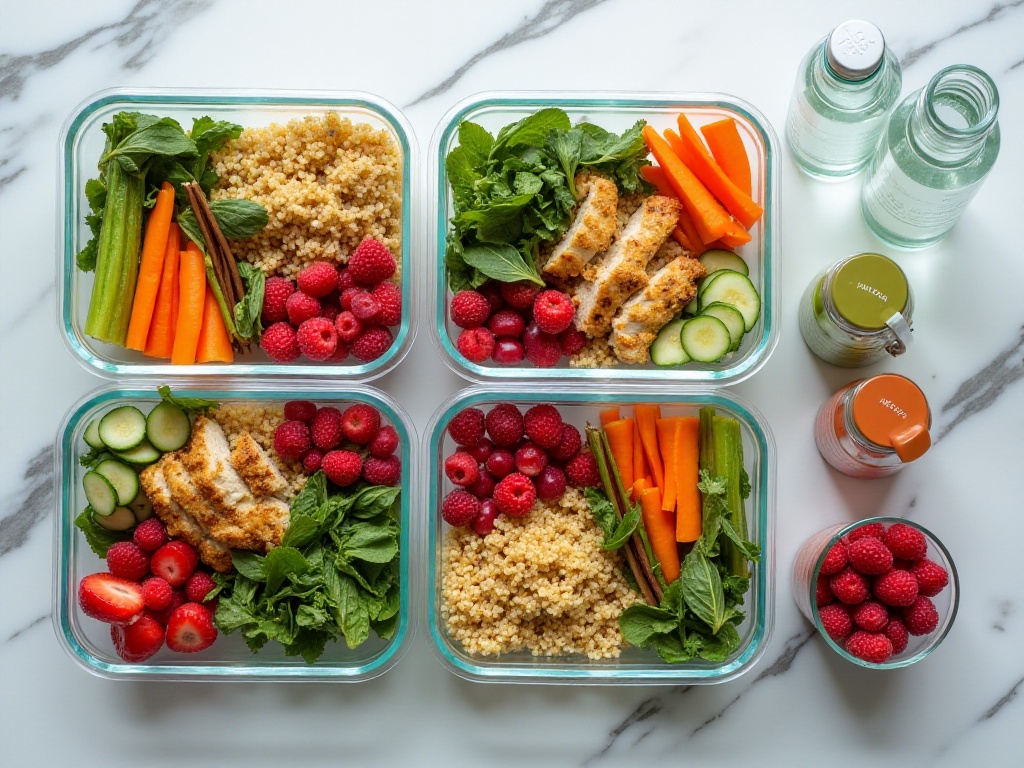Introduction
I'm really fed up lately! Every day it's either takeout or instant noodles. When work gets busy, I even forget to drink water, and I feel like something's not right with my body. I know you must feel the same way - seeing all those healthy lifestyle posts on social media, thinking "I should start eating healthy too," but always giving up after a brief attempt.
I'm just like you, and after countless failed attempts, I finally found a healthy eating approach that works for me. Today I'll share my experiences - this isn't some complicated technical article that'll give you a headache, just a casual chat between friends. I hope it helps those of you who are also struggling on your healthy eating journey.
Nutritional Balance
To be honest, when I first started changing my diet, I thought I just needed to eat less, trying to starve myself into becoming a fairy. The result? Not only was I dizzy from hunger, but I also couldn't control my binge eating at night. Later I realized that healthy eating isn't about starving yourself - it's about eating the right things.
Dietary Fiber is Key
When I first started changing my eating habits, the most shocking discovery was how little dietary fiber I was consuming! Nutritionists say we need 25-30 grams of fiber daily, but when I calculated my regular intake - my goodness, it was probably less than 15 grams.
It's like your intestines are a busy highway with constant traffic, but without any cleaners to maintain it - problems are bound to arise over time. Dietary fiber is that cleaner, responsible for keeping your digestive system flowing smoothly and clean.
Now I have a super practical trick: the first thing I do every morning is eat a fruit, like an apple, pear, or orange. For lunch and dinner, I fill half my plate with vegetables.
Think of dividing your plate into four sections: two sections for colorful vegetables like broccoli, carrots, and Chinese flowering cabbage; one section for whole grains like brown rice, oatmeal, or whole wheat bread; and the last section for protein like chicken, fish, or soy products. This combination is super nutritionally balanced and appetizing too.
I also discovered something interesting - vegetables and fruits of different colors have different nutritional content. For example, orange carrots are rich in beta-carotene, green broccoli is high in vitamin C, and purple eggplants contain anthocyanins. So now when I choose vegetables and fruits, I deliberately pick different colors to make my plate look like a rainbow.
Protein is Important
Regarding protein, I used to have major misconceptions. I thought only fitness enthusiasts needed to pay special attention to protein intake, and regular people could just eat whatever. Until a health check-up when the doctor said my protein intake was insufficient - that's when I started seriously researching this topic.
According to recent studies, 10-35% of our daily calories should come from protein. That might sound abstract, so here's an example: if you're like me and consume 2000 calories daily, your protein intake should be between 50-175 grams.
What does this mean? A cooked egg contains about 6 grams of protein, a palm-sized piece of chicken breast contains about 30 grams, and 100 grams of tofu contains about 8 grams. So you see, to reach daily protein requirements, you need to consciously include protein-rich foods in each meal.
My current approach is to always have an egg or some Greek yogurt for breakfast, and a palm-sized portion of meat or fish for both lunch and dinner, along with some soy products. If you're vegetarian, you'll need to eat more legumes, nuts, and soy products.
I recently discovered a super useful tip: sprinkle pumpkin seeds or almond slices on salads - it not only increases protein intake but also adds texture. Adding a scoop of protein powder to smoothies is also a good way to supplement protein.

Behavioral Changes
Eating Habits
Speaking of this, I really need to examine myself. Previously, when eating lunch at work, I would scroll through my phone while eating, and often couldn't remember what or how much I ate afterward. Worse still, because my attention was on the phone, I would often overeat without realizing it.
Research shows that people who eat while looking at screens consume 15-20% more calories on average. What does this mean? If you should normally eat 500 calories per meal, you might unconsciously eat an extra 75-100 calories while looking at your phone. Over three meals a day, this habit alone can lead to an extra 225-300 calories!
Now I set a "focused eating time" where I put my phone in my bag or somewhere out of sight while eating. It might feel boring at first, but gradually you'll discover that this helps you better taste your food and be more aware of your satiety signals.
I also found an unexpected benefit of focused eating: my digestion seems to have improved. I used to feel bloated after meals, but now that I eat more slowly and chew thoroughly, this happens much less frequently.
I've also made a rule for myself: chew each bite at least 20 times. At first, I had to count silently, but now it's become a habit. This not only helps with digestion but also lets you truly enjoy the taste of your food.
Meal Timing Management
Speaking of eating habits, time management is also crucial. I used to eat irregularly, just grabbing whatever when busy, which often led to binge eating. Now I try to maintain fixed meal times - breakfast at 7:30 AM, lunch at noon, and dinner at 6:30 PM.
This regular eating schedule not only helps establish a stable metabolic rhythm but also prevents overeating due to extreme hunger. If I really can't control the timing, I carry healthy snacks like fruits or nuts to prevent blood sugar from dropping too low.
Smart Meal Prep
Weekend Battle Plan
The change I'm most proud of is learning to prepare meals for the week in advance. It seemed really troublesome at first, but after sticking with it, I discovered it's absolutely life-changing!
Studies show that people who prepare weekly meals save 4-6 hours per week on average and reduce takeout expenses by 30%. Think about it - all that saved time and money can be used for more meaningful things.
My current approach is to spend two hours every weekend preparing lunch ingredients for the next week. It might sound tiring, but it's actually super efficient. I first make a list, plan what to eat each day, then buy all ingredients at once.
For example, I'll cook several chicken breasts at once, roast a large batch of vegetables, and prepare several portions of quinoa or brown rice. Then I divide these into different containers and store them in the refrigerator. Each morning before work, I just grab one portion and add some fresh lettuce or fruit, and a healthy lunch is ready.
This not only saves time but also helps control food quality. Since I prepare all ingredients myself, I know exactly what's in them, without too many additives and seasonings. Plus, batch processing saves costs in both purchasing and cooking.
Shopping Tips
Speaking of preparing ingredients, I think shopping skills are also really important. I used to buy things randomly as I thought of them, often buying too much that couldn't be used up, or forgetting important ingredients. Now I write shopping lists first and pay special attention to ingredient freshness and shelf life.
For example, I buy seasonal vegetables and fruits, which are not only fresh but also more affordable. For meat and seafood, I usually divide them into small portions and freeze them, making them convenient to use without waste.
I discovered a particularly useful tip: when shopping at the supermarket, try to walk around the perimeter. The outer edges usually have fresh produce, meat, and dairy products, while the middle aisles mainly contain snacks and processed foods. This shopping pattern helps you buy healthier ingredients and avoid junk food temptations.

Food Storage

Smart Stockpiling
Speaking of storing ingredients, I especially recommend canned fish. I know many people frown at the mention of canned food, thinking it's not healthy enough. But actually, canned tuna and sardines are not only highly nutritious but also very convenient.
Here's a tip: choose water-packed rather than oil-packed varieties to reduce unnecessary fat intake. Plus, canned fish is rich in omega-3 fatty acids, which are especially beneficial for cardiovascular health.
Besides canned fish, I keep whole grains like oats, quinoa, and brown rice in my pantry. These ingredients have a long shelf life and can be used in many ways. Oats, for example, can be used for breakfast cereal, energy bars, or even ground into flour for bread.
I also keep some frozen vegetables in the freezer. Many people might think frozen vegetables aren't as good as fresh ones, but actually, many frozen vegetables are frozen immediately after harvesting, preserving their nutritional content well. Plus, they're really convenient - just take them out whenever you need them.

Scientific Storage
Organizing ingredients after purchase is also a science. My current refrigerator organization has a complete system: frequently used ingredients like fruits and yogurt on the top shelf; meat and seafood in the middle; vegetables on the bottom.
I keep condiments and drinks in the door compartments. However, it's important to note that eggs shouldn't be stored in the door, as temperature fluctuations from opening and closing can affect their shelf life.
Eating Habits
Label Reading
Honestly, I used to barely look at nutrition labels when shopping, just focusing on words like "low-fat" or "sugar-free" on the packaging. Now I realize how naive that was!
Take "low-fat" yogurt for example - while it might be low in fat, manufacturers often add lots of sugar to maintain taste. According to nutrition society guidelines, our daily added sugar intake shouldn't exceed 10% of total calories.
Now I have my own method for reading nutrition labels: first check the ingredients list, as ingredients are listed by quantity from most to least. If sugar is among the top three ingredients, the product might not be very healthy. Then look at the nutritional content per 100g, especially sugar, sodium, and trans fat content.
I've discovered that many seemingly healthy foods actually hide secrets. For example, some "whole wheat" bread is mainly made from refined flour with just a bit of whole wheat flour added. So now when buying food, I carefully read the ingredients list and don't get fooled by nutritional claims on packaging.

Beverage Choices
Speaking of healthy eating, beverage choice is also crucial. I used to love all kinds of drinks - milk tea, juice, sodas - feeling like life wouldn't be fun without them. But after calculating, I realized these drinks were giving me lots of "empty calories."
Now my main beverages are water and unsweetened tea. If I want something flavored, I'll add a slice of lemon or some mint leaves to water. On weekends when I'm in a good mood, I might make fresh fruit and vegetable juice, but without adding sugar, keeping the natural fruit taste.
Family Building
Family Mobilization
If you have children, this becomes even more important. Research shows that parents' eating habits directly influence their children's future food choices. We have an interesting tradition in our family: every Sunday, we let our child be the little chef.
This activity is really fun - it not only cultivates children's interest in healthy food but also strengthens family bonds. We go to the supermarket together to select ingredients, discuss what to cook, then work together in the kitchen. Although it might make the kitchen messy, seeing the children's proud smiles makes it all worthwhile.
Moreover, through this approach, children can truly understand where food comes from and learn to be grateful and cherish it. I've found that when children participate in food preparation, their acceptance of healthy food greatly increases.
Creating a Healthy Home Environment
To maintain healthy eating habits, creating a supportive home environment is also important. For example, we now rarely buy snacks and drinks, replacing them with fresh fruits and nuts.
Pay attention to food placement too - put healthy foods in prominent positions, like fruit on the coffee table and nuts near the TV cabinet. This way, when you want a snack, the first things you see are these healthy choices.
We also regularly hold family cooking competitions where everyone has to create delicious dishes using healthy ingredients. This not only sparks creativity but also makes healthy eating more fun.
Conclusion
After this period of trial and adjustment, I've really felt the changes that healthy eating brings. Not only has my body become lighter, but my mental state has also improved greatly. Most importantly, I've discovered that healthy eating isn't actually painful - the key is finding what works for you.
Remember, change doesn't need to happen overnight - every small step is important. Maybe today you just decide to drink one more glass of water, and tomorrow you might start preparing healthy lunches. These seemingly small changes add up to amazing results.
Now, let's begin this healthy eating transformation journey together! I believe that through continuous trial and adjustment, you'll definitely find your own healthy lifestyle.







